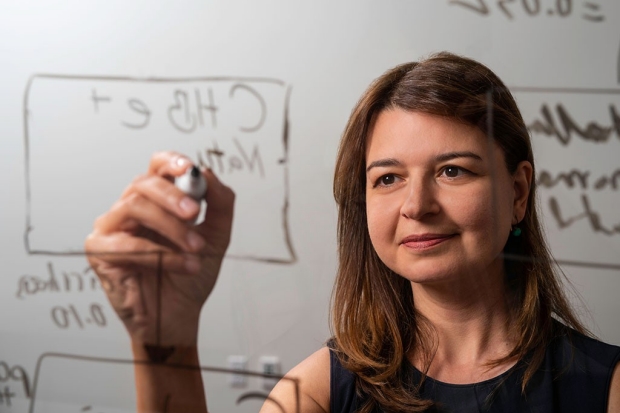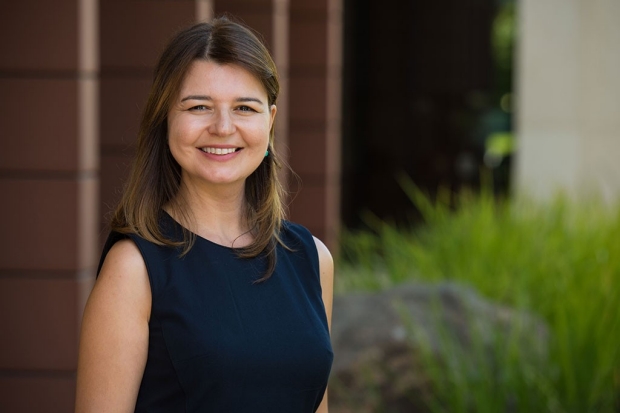
Mehlika Toy merged her interests in infectious diseases and mathematics to forge a career in decision science. She builds models to estimate the impact of clinical interventions to inform health policy.
October 2, 2018 - By Kimber Price

Mehlika Toy focuses her research on finding ways to halt the spread of infectious disease, particularly chronic hepatitis B. She has developed models to determine the cost-effectiveness of various hepatitis B interventions.
Steve Fisch
Even as a young girl, Mehlika Toy followed health and health care stories on the news. She was especially fascinated by reports of influenza and other outbreaks around the world. The Netherlands, where she grew up, has an extensive and successful screening and vaccination program, which is probably one reason why Toy was so interested in how disease could spread in other parts of the world.
Toy, PhD, now a scientist at the Asian Liver Center at the Stanford School of Medicine, has spent the last dozen years trying to figure out the best ways to control infectious disease, particularly chronic hepatitis B. The virus is often asymptomatic and spreads via blood and bodily fluids. It can lead to death by cirrhosis or liver cancer.
Although the virus is preventable with vaccination and treatable with antiviral medication, 800,000 deaths per year worldwide are attributed to undiagnosed or untreated hepatitis B. In the United States, an estimated 1.3 million people have chronic hepatitis B, yet two-thirds don’t know it. Diagnosing more cases of chronic hepatitis B in order to monitor or treat the disease is the best strategy to prevent its spread.
Toy has emerged as a leading authority on the cost-effectiveness of hepatitis B treatment and care and has influenced health care policy around the world. She was chosen to develop a mathematical model for the World Health Organization to use as a tool to calculate country-specific interventions for eliminating the public health burden of hepatitis B by the year 2030.
“Mehlika has a great rapport with others in the field, which helps with her success, as this kind of work is something you cannot do alone,” said David Hutton, PhD, associate professor of health management and policy and of industrial and operations engineering at the University of Michigan. “Usually, you need to be able to work with experts in many different countries.”
Her parents are Turkish and raised Toy and her sister in the Netherlands. In addition to Dutch and Turkish, she speaks English, German and some French. Being multilingual has come in handy in her work with the World Health Organization. “It helps to have a multicultural background,” she said. “You need to be able to adapt easily to conditions and the people within the areas where you’re working.”

Toy, a decision scientist, came to Stanford in 2013 to work with Samuel So, executive director of the Asian Liver Center.
Steve Fisch
Toy initially studied epidemiology, the branch of medicine focused on the prevalence and distribution of disease. But one of her professors got her hooked on mathematical modeling. She earned a PhD in public health at Erasmus University Medical Center in Rotterdam and became a decision scientist.
“A decision scientist helps to pick up loose ends when decisions have to be made. They consider, among other things, the costs associated with various alternatives,” Toy said. “For instance, when faced with cancer treatment alternatives, what is the best alternative for the population and the person?”
As a graduate student, Toy looked at the public health impact of antiviral therapy for hepatitis B. Her work resulted in public health policy changes in the Netherlands and in Turkey. After completing her PhD, Toy accepted a fellowship at Harvard to study international health and spent a good deal of time in China doing research. She focused on several cost-effective interventions for chronic hepatitis B infection and became a recognized expert, publishing her work in prominent journals. China also enacted health policy changes because of Toy’s work, which provided policymakers the evidence they needed to procure low-cost drugs for a national viral hepatitis treatment program.
To build her cost-effectiveness models, Toy starts with figuring out how many lives can be saved with a particular treatment, and then she plays with variables contributing to costs to see under what conditions the treatment will be cost-effective or cost-saving. She does this by asking, “What if?” If there is a 10 percent prevalence rate of a disease, but most of it is seen in adult males, what if 90 percent of those men were screened for the disease? What if 80 percent of those who had the disease got treated? She said she always has to think of the future to include factors that may not be relevant now. A cure might be within reach, or bioindustry costs may change, or the political climate could impact a number of variables, she said.
We need simplified tools to communicate complex information to patients.
One of the biggest challenges of being a decision scientist is getting access to the specific data sets needed to build a particular model, Toy said. “Sometimes physicians or researchers or drug companies just don’t want to share data with you,” she said. Now that she has established herself as a leader in the field, it’s easier to develop collaborations.
Toy came to Stanford in 2013 as a postdoctoral scholar to work with Samuel So, MD, executive director of the Asian Liver Center, which seeks to address the disproportionately high prevalence of chronic hepatitis B and liver cancer in Asians and Asian-Americans. Toy traveled to the Philippines, Mongolia, Indonesia and Australia, among other places, to contribute to the center’s outreach efforts and to gather information for WHO.
The best part about being a decision scientist, Toy said, is being able to create user-friendly tools that health ministries can use to inform decisions affecting health policy. She built a model in a spreadsheet that was made freely available to health ministries and is now available online. She recently gave a two-day workshop in Indonesia to teach health care leaders how to use it and how to enter and adjust variable amounts to lower the cost of health care. “It also serves as an outreach tool,” she said. “By emphasizing that hepatitis B is a serious disease, this sort of outreach can impact health policy.”
Toy was commissioned by the National Academies of Sciences, Engineering and Medicine to model the potential impact of improving chronic hepatitis B patient care and treatment in the United States. “I was very humbled that I could be asked to do such a thing,” she said. “It made me very happy and proud to be calling the U.S. my home. It really made me feel like I was at home.” Her study, published in March of 2017, concluded that it was feasible to eliminate the public health problem of hepatitis B in the country by 2030 and formed the basis of a national strategy that changed health care policy in the United States.
She was invited by the Centers for Disease Control and Prevention to present her hepatitis B model the following month at the viral hepatitis summit in Atlanta. Her colleagues praised her ability to make such a complicated model easy to understand in the presentation. The conference was streamed live. Her family and friends were thrilled to be able to watch from over 4,000 miles away. “They took so many screenshots!” Toy said.
Looking to the future, Toy is interested in expanding her work to have a broader reach and developing applications that haven’t been explored yet. She’s working on a prediction model of liver cancer for patients to use. Nothing like that is currently available.
“By entering basic data such as age, gender and blood test results, the tool will calculate the probability of liver cancer in a given amount of time and can potentially guide the patient to follow recommended monitoring and treatment,” Toy said. “We need simplified tools to communicate complex information to patients.”
It will be a collaborative effort, drawing on the expertise of clinical psychologists, user-experience designers, biomedical informaticists and decision scientists. “This is using public outreach on an individual level to affect patient outcomes,” Toy said. “Putting these powerful tools in the hands of patients has the potential to make a huge impact on behavior change.”
Does Toy use decision models in her personal life? When she was in Boston, she used modeling for decision-making in life just for fun with a few colleagues, she said. “We would try to answer a question in our personal life and give weights/utilities to some of these states to predict an outcome.” She doesn’t do that anymore but does apply the pragmatic part of modeling to her life. “I used to be more spontaneous with decision-making, but lately I am trying to take my time,” she said.
Kimber PriceKimber Price is a science-writing intern for the medical school's Office of Communication & Public Affairs.
About Stanford Medicine
Stanford Medicine is an integrated academic health system comprising the Stanford School of Medicine and adult and pediatric health care delivery systems. Together, they harness the full potential of biomedicine through collaborative research, education and clinical care for patients. For more information, please visit med.stanford.edu.